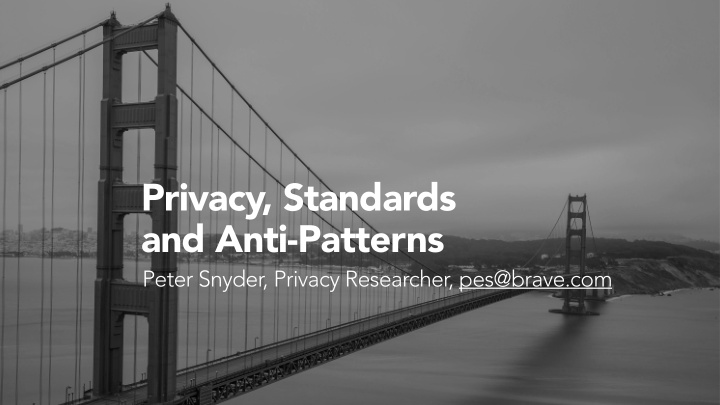



Privacy, Standards and Anti-Patterns Peter Snyder, Privacy Researcher, pes@brave.com
Overview Standards as a privacy focused implementor How the standards process makes privacy difficult (and how it can be fixed) Bonus concerns and conclusions � 2
Overview Standards as a privacy focused implementor How the standards process makes privacy difficult (and how it can be fixed) Bonus concerns and conclusions � 3
Privacy in Brave Tighter Default Storage Controls Tor Integration Resource Blocking Web API / DOM Modifications � 4
Privacy in Brave Tighter Default Storage Controls Tor Integration Web Standards / W3C / IETF Resource Blocking Web API / DOM Modifications � 5
Web API Modifications
Web API Modifications
Web Audio Fingerprinting Standard says websites can query hardware Hardware is pseudo-identifying Enough pseudo-identifiers yield a real identifier So Brave breaks the standard… � 11
Breaking Standards for Privacy Hardware Detection: Font Enumeration: • Web Audio • Canvas • WebGL • SVG • WebUSB Display Information: • Battery API • Client Hints Network Information • WebRTC Browsing History: • Referrer Policy 12 �
Overview Standards as a privacy focused implementor How the standards process makes privacy difficult (and how it can be fixed) Bonus concerns and conclusions � 13
Three Standards Privacy Anti-Patterns
Three Standards Privacy Anti-Patterns
1. Defined Functionality, Non-Normative Mitigations
Privacy Risk w/ Non-Normative Mitigations Privacy-harming / risky functionality “Privacy considerations" section, but non-standardized mitigation The Web assumes the dominant implementation, instead of the standard Result: Harm is “locked in” / out of control of the standards process � 17
Result Well described functionality Vaguely / undefined / unclear mitigations Web assumes the defined functionality, privacy-harm gets locked in Solution: Make mitigations normative and standardized! � 21
1. Defined Functionality, Non-Normative Mitigations 2. Uncommon Use Case, Common Availability
Uncommon Use Case, Common Availability Genuinely useful functionality, for niche scenarios Functionality is made widely available (first-party, third-party, frames, etc.) Co-opted by tracking, code-paths assume availability Result: can't be removed, even from irrelevant sites � 23
Widely Available Sites / benign code expects Removing / blocking breaks benign sites
Lots of rare-use-case functionality Brightness sensors WebVR Machine Learning APIs High Resolution Timers Vibration WebGL operations Tracing APIs Many many many more… � 29
Lesson Learned Assume people will find bad uses for your functionality General access -> difficult to remove / modify Solution: Restrict access to the use cases you care about • User gestures • Permission prompts • Not-in-frames � 30
1. Defined Functionality, Non-Normative Mitigations 2. Uncommon Use Case, Common Availability 3. “No worse than the status quo”
“No worse than the status quo” Privacy-harming / risky functionality “Information is available elsewhere, so no additional harm” Result: Web compat difficulty expands… � 32
Client Server
Client Server GET /index.html
Client Server GET /index.html Accept-CH: DPR Accept-CH: Viewport-Width
Client Server GET /index.html Accept-CH: DPR Accept-CH: Viewport-Width DPR: 2 Viewport-Width: 1434
Values in Client Hints are Identifying Eckersley, Peter. "How unique is your web browser?." PETS 2010 Viewport height and width Laperdrix et al. ”Beauty and the beast: Diverting modern web browsers to build unique browser fingerprints." S&P 2016. Device color depth Englehardt et al. "Online Tracking: A 1-million-site Measurement and Analysis.” CCS 2016 The above are being used often! � 38
Client Hints Authors’ Current Position This information is already available No further exposure / no marginal harm Brave’s Concerns with the Client-Hints Proposal https://brave.com/brave-and-client-hints/ � 39
Lesson Learned “Horizontal” privacy risk is technological debt Same data in more places entrenches the risk Solution: Treat all additional privacy risk as equally problematic � 41
Overview Standards as a privacy focused implementor How the standards process makes privacy difficult (and how it can be fixed) Bonus concerns and conclusions � 42
Bonus anti-patterns “This privacy concern is addressed by an upcoming standard…” “This just formalizes existing bad practice…” "Site owners want it, users like sites, so by the transitive property…” � 43
Bonus suggestions / concerns / worries / rants Pump the breaks on everything Complexity is a privacy risk Amount of “standards” work that is shipped-than-standardized � 44
Overview Standards as a privacy focused implementor How the standards process makes privacy difficult (and how it can be fixed) Bonus concerns and conclusions � 45
Conclusion Privacy preserving standards are important to improving the Web. Weak standards make it difficult for privacy-interested parties to improve things. A few small changes to privacy Pete Snyder criteria in standards would make a Privacy Researcher huge difference. pes@brave.com
Recommend
More recommend